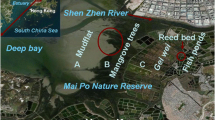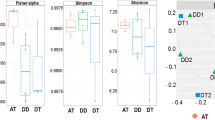Abstract
Nitrite-dependent anaerobic methane oxidation (n-damo) process is unique in linking the microbial carbon and nitrogen cycles, but the presence of n-damo bacteria in marine ecosystem and the associated environmental factors are still poorly understood. In the present study, detection of n-damo bacteria using 16S rRNA and pmoA gene-based PCR primers was successfully employed to reveal their diversity and distribution in the surface and subsurface sediments of the South China Sea (SCS). The widespread occurrence of n-damo bacteria in both the surface and subsurface sediments with high diversity has been confirmed in this study. The pmoA gene-amplified sequences clustered within three newly erected subclusters, namely SCS-1, SCS-2, and SCS-3, suggesting the unique niche specificity of n-damo bacteria in the marine ecosystem. Results indicated the presence of n-damo bacteria in the west Pacific Ocean with a wide distribution from the continental shelf (E201S) to the deep abyss (E407S and E407B). Community structures of n-damo bacteria in SCS are clearly different from those of nonmarine ones known. It is also found that NO x − and NH4 + affected the community structures and distribution of n-damo bacteria in the SCS sediments differently. Salinity is another important factor identified, shaping the n-damo communities in marine environments. The community based on pmoA gene-amplified sequences, and community richness and diversity based on 16S rRNA gene-amplified sequences correlated with temperature.





Similar content being viewed by others
References
Aristegui J, Montero MF (2005) Temporal and spatial changes in plankton respiration and biomass in the Canary Islands region: the effect of mesoscale variability. J Mar Syst 54:65–82
Arnosti C, Finke N, Larsen O, Ghobrial S (2005) Anoxic carbon degradation in Arctic sediments: microbial transformations of complex substrates. Geochim Cosmochim Acta 69:2309–2320
Boetius A, Wenzhofer F (2013) Seafloor oxygen consumption fuelled by methane from cold seeps. Nat Geosci 6:725–734
Boetius A, Ravenschlag K, Schubert CJ, Rickert D, Widdel F, Gieseke A, Amann R, Jorgensen BB, Witte U, Pfannkuche O (2000) A marine microbial consortium apparently mediating anaerobic oxidation of methane. Nature 407:623–626
Braak CJF, Smilauer P (2002) CANOCO reference manual and user's guide to Canoco for Windows: software for canonical community ordination (version 4.5). Microcomputer Power, Ithaca
Chao A (1984) Non-parametric estimation of the number of classes in a population. Scand J Stat 11:265–270
Chen J, Jiang XW, Gu JD (2014) Existence of novel phylotypes of nitrite-dependent anaerobic methane-oxidizing bacteria in surface and subsurface sediments of the South China Sea. Geomicrobiol J (In press)
del Giorgio PA, Duarte CM (2002) Respiration in the open ocean. Nature 420:379–384
DeLong EF, Preston CM, Mincer T, Rich V, Hallam SJ, Frigaard NU, Martinez A, Sullivan MB, Edwards R, Brito BR, Chisholm SW, Karl DM (2006) Community genomics among stratified microbial assemblages in the ocean's interior. Science 311:496–503
Deutzmann JS, Schink B (2011) Anaerobic oxidation of methane in sediments of Lake Constance, an oligotrophic freshwater lake. Appl Environ Microbiol 77:4429–4436
Ettwig KF, van Alen T, van de Pas-Schoonen KT, Jetten MSM, Strous M (2009) Enrichment and molecular detection of denitrifying methanotrophic bacteria of the NC10 phylum. Appl Environ Microbiol 75:3656–3662
Ettwig KF, Butler MK, Le Paslier D, Pelletier E, Mangenot S, Kuypers MM, Schreiber F, Dutilh BE, Zedelius J, de Beer D, Gloerich J, Wessels HJ, van Alen T, Luesken F, Wu ML, van de Pas-Schoonen KT, Op den Camp HJ, Janssen-Megens EM, Francoijs KJ, Stunnenberg H, Weissenbach J, Jetten MS, Strous M (2010) Nitrite-driven anaerobic methane oxidation by oxygenic bacteria. Nature 464:543–548
Francis CA, Roberts KJ, Beman JM, Santoro AE, Oakley BB (2005) Ubiquity and diversity of ammonia-oxidizing archaea in water columns and sediments of the ocean. Proc Natl Acad Sci U S A 102:14683–14688
Hammer Ø, Harper DAT, Ryan PD (2001) PAST: paleontological statistics software package for education and data analysis. Paleontol Electron 4:9
Han P, Gu JD (2013) A newly designed degenerate PCR primer based on pmoA gene for detection of nitrite-dependent anaerobic methane-oxidizing bacteria from different ecological niches. Appl Microbiol Biotechnol 97:10155–10162
Haroon MF, Hu S, Shi Y, Imelfort M, Keller J, Hugenholtz P, Yuan Z, Tyson GW (2013) Anaerobic oxidation of methane coupled to nitrate reduction in a novel archaeal lineage. Nature 500:567–570
He Z, Cai C, Geng S, Lou L, Xu X, Zheng P, Hu B (2013) Mdodeling a nitrite-dependent anaerobic methane oxidation process: parameters identification and model evaluation. Bioresour Technol 147:315–320
Holmes AJ, Costello A, Lidstrom ME, Murrell JC (1995) Evidence that particulate methane monooxygenase and ammonia monooxygenase may be evolutionarily related. FEMS Microbiol Lett 132:203–208
Hu BL, Shen LD, Lian X, Zhu Q, Liu S, Huang Q, He ZF, Geng S, Cheng DQ, Lou LP, Xu XY, Zheng P, He YF (2014) Evidence for nitrite-dependent anaerobic methane oxidation as a previously overlooked microbial methane sink in wetlands. Proc Natl Acad Sci U S A. doi:10.1073/pnas.1318393111
Jorgensen BB, Boetius A (2007) Feast and famine—microbial life in the deep-sea bed. Nat Rev Microbiol 5:770–781
Katoh K, Standley DM (2013) MAFFT Multiple Sequence Alignment Software Version 7: improvements in performance and usability. Mol Biol Evol 30:772–780
Kojima H, Tsutsumi M, Ishikawa K, Iwata T, Mussmann M, Fukui M (2012) Distribution of putative denitrifying methane oxidizing bacteria in sediment of a freshwater lake, Lake Biwa. Syst Appl Microbiol 35:233–238
Lauro FM, Chastain RA, Blankenship LE, Yayanos AA, Bartlett DH (2007) The unique 16S rRNA genes of piezophiles reflect both phylogeny and adaptation. Appl Environ Microbiol 73:838–845
Li M, Hong Y, Cao H, Klotz MG, Gu JD (2013a) Diversity, abundance, and distribution of NO-forming nitrite reductase-encoding genes in deep-sea subsurface sediments of the South China Sea. Geobiology 11:170–179
Li M, Hong YG, Cao HL, Gu JD (2013b) Community structures and distribution of anaerobic ammonium oxidizing and nirS-rncoding nitrite-reducing bacteria in surface sediments of the South China Sea. Microb Ecol 66:281–296
Li-Dong S, Qun Z, Shuai L, Ping D, Jiang-Ning Z, Dong-Qing C, Xiang-Yang X, Ping Z, Bao-Lan H (2014) Molecular evidence for nitrite-dependent anaerobic methane-oxidising bacteria in the Jiaojiang Estuary of the East Sea (China). Appl Microbiol Biotechnol. doi:10.1007/s00253-00014-05556-00253
Lozupone C, Knight R (2005) UniFrac: a new phylogenetic method for comparing microbial communities. Appl Environ Microbiol 71:8228–8235
Lozupone C, Hamady M, Knight R (2006) UniFrac—an online tool for comparing microbial community diversity in a phylogenetic context. BMC Bioinforma 7:371
Luesken FA, van Alen TA, van der Biezen E, Frijters C, Toonen G, Kampman C, Hendrickx TL, Zeeman G, Temmink H, Strous M, Op den Camp HJ, Jetten MS (2011a) Diversity and enrichment of nitrite-dependent anaerobic methane oxidizing bacteria from wastewater sludge. Appl Microbiol Biotechnol 92:845–854
Luesken FA, Zhu BL, van Alen TA, Butler MK, Diaz MR, Song B, den Camp HJMO, Jetten MSM, Ettwig KF (2011b) pmoA primers for detection of anaerobic methanotrophs. Appl Environ Microbiol 77:3877–3880
Luesken FA, Wu ML, Op den Camp HJ, Keltjens JT, Stunnenberg H, Francoijs KJ, Strous M, Jetten MS (2012) Effect of oxygen on the anaerobic methanotroph ‘Candidatus Methylomirabilis oxyfera’: kinetic and transcriptional analysis. Environ Microbiol 14:1024–1034
Magurran AE (1988) Ecological diversity and its measurement. Princeton University Press, Princeton, pp 34–39
Meulepas RJW, Jagersma CG, Khadem AF, Buisman CJN, Stams AJM, Lens PNL (2009) Effect of environmental conditions on sulfate reduction with methane as electron donor by an Eckernforde Bay enrichment. Environ Sci Technol 43:6553–6559
Mincer TJ, Church MJ, Taylor LT, Preston C, Kar DM, DeLong EF (2007) Quantitative distribution of presumptive archaeal and bacterial nitrifiers in Monterey Bay and the North Pacific Subtropical Gyre. Environ Microbiol 9:1162–1175
Orcutt BN, Sylvan JB, Knab NJ, Edwards KJ (2011) Microbial ecology of the dark ocean above, at, and below the seafloor. Microbiol Mol Biol Rev 75:361–422
Raghoebarsing AA, Pol A, van de Pas-Schoonen KT, Smolders AJP, Ettwig KF, Rijpstra WIC, Schouten S, Damste JSS, Op den Camp HJM, Jetten MSM, Strous M (2006) A microbial consortium couples anaerobic methane oxidation to denitrification. Nature 440:918–921
Shen LD, Liu S, Zhu Q, Li XY, Cai C, Cheng DQ, Lou LP, Xu XY, Zheng P, Hu BL (2013) Distribution and diversity of nitrite-dependent anaerobic methane-oxidising bacteria in the sediments of the Qiantang River. Microb Ecol 67:341–349
Tamura K, Peterson D, Peterson N, Stecher G, Nei M, Kumar S (2011) MEGA5: molecular evolutionary genetics analysis using maximum likelihood, evolutionary distance, and maximum parsimony methods. Mol Biol Evol 28:2731–2739
Wang Y, Zhu G, Harhangi HR, Zhu B, Jetten MS, Yin C, Op den Camp HJ (2012) Co-occurrence and distribution of nitrite-dependent anaerobic ammonium and methane oxidizing bacteria in a paddy soil. FEMS Microbiol Lett 336:79–88
Whiticar ML (1990) A geochemial perspective of natural gas and atmospheric methane. Org Geochem 16:531–547
Wright ES, Yilmaz LS, Noguera DR (2012) DECIPHER, a search-based approach to chimera identification for 16S rRNA sequences. Appl Environ Microbiol 78:717–725
Wu ML, Ettwig KF, Jetten MS, Strous M, Keltjens JT, van Niftrik L (2011) A new intra-aerobic metabolism in the nitrite-dependent anaerobic methane-oxidizing bacterium Candidatus ‘Methylomirabilis oxyfera’. Biochem Soc Trans 39:243–248
Wuchter C, Abbas B, Coolen MJ, Herfort L, van Bleijswijk J, Timmers P, Strous M, Teira E, Herndl GJ, Middelburg JJ, Schouten S, Sinninghe Damste JS (2006) Archaeal nitrification in the ocean. Proc Natl Acad Sci U S A 103:12317–12322
Yang J, Jiang HC, Wu G, Hou WG, Sun YJ, Lai ZP, Dong HL (2012) Co-occurrence of nitrite-dependent anaerobic methane oxidizing and anaerobic ammonia oxidizing bacteria in two Qinghai-Tibetan saline lakes. Front Earth Sci 6:383–391
Yu YN, Breitbart M, McNairnie P, Rohwer F (2006) FastGroupII: a web-based bioinformatics platform for analyses of large 16S rDNA libraries. BMC Bioinforma 7:57
Zhang Y, Henriet JP, Bursens J, Boon N (2010) Stimulation of in vitro anaerobic oxidation of methane rate in a continuous high-pressure bioreactor. Bioresour Technol 101:3132–3138
Zhu GB, Zhou LL, Jiang B, Wang Y, Wang SY, Jetten MSM, Yin CQ (2013a) Biogeographical distribution of nitrite dependent anaerobic methanotrophic bacteria in wetland ecosystems: from regional scale to global scale. NCBI Genbank web http://www.ncbi.nlm.nih.gov/nuccore/. Accessed 24 March 2014
Zhu Q, Shen LD, Hu BL, Lou LP, Cheng DQ (2013b) Molecular detection of denitrifying anaerobic oxidizing bacteria in the sediment of West Lake, Hangzhou. Acta Sci Circumst 33:1321–1325
Acknowledgments
This project was supported by the Hong Kong PhD Fellowship (JC), the University of Hong Kong Foundation PhD Fellowship (ZCZ), and RGC GRF grant no. 701913 (J-DG). Additional financial support for this research project was from the laboratory fund. We thank Dr. Li-Ying Wang and Miss Han Meng for the useful discussions and Ms Kelly Lau for the general laboratory assistance.
Author information
Authors and Affiliations
Corresponding author
Electronic supplementary material
Below is the link to the electronic supplementary material.
ESM 1
(PDF 559 kb)
Rights and permissions
About this article
Cite this article
Chen, J., Zhou, ZC. & Gu, JD. Occurrence and diversity of nitrite-dependent anaerobic methane oxidation bacteria in the sediments of the South China Sea revealed by amplification of both 16S rRNA and pmoA genes. Appl Microbiol Biotechnol 98, 5685–5696 (2014). https://doi.org/10.1007/s00253-014-5733-4
Received:
Revised:
Accepted:
Published:
Issue Date:
DOI: https://doi.org/10.1007/s00253-014-5733-4




